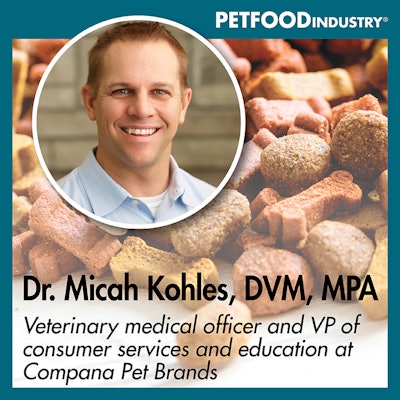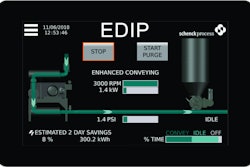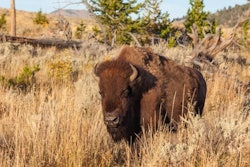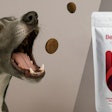
Veterinary Medical Officer and Vice President of Consumer Services and Education for Compana Pet Brands and Oxbow Animal Health Dr. Micah Kohles did a deep dive with me into the small animal pet food segment. We covered everything from innovation and trends to pet ownership and insect protein regulations. There was a lot to get into, so don't miss out!
The below transcript is from Episode 19 of the Trending: Pet Food podcast, where I spoke Veterinary Medical Officer and Vice President of Consumer Services and Education for Compana Pet Brands and Oxbow Animal Health Dr. Micah Kohles about top trends in the small animal pet food space. You can find the episode at www.PetfoodIndustry.com/trending-pet-food-podcast, on SoundCloud or on your favorite podcast platform. This episode originally aired on October 12, 2022.
Lindsay Beaton – Editor, Petfood Industry magazine and Host, Trending: Pet Food podcast
Hello, and welcome to Trending: Pet Food, the industry podcast where we cover all the latest hot topics and trends in pet food. I'm your host and Editor of Petfood Industry magazine Lindsay Beaton, and I'm here today with Veterinary Medical Officer and Vice President of Consumer Services and Education for Compana Pet Brands and Oxbow Animal Health Dr. Micah Kohles. Hi Dr. Kohles, and welcome.
Dr. Micah Kohles – Veterinary Medical Officer and Vice President of Consumer Services and Education for Compana Pet Brands and Oxbow Animal Health
Thank you very much! Looking forward to chatting with you for a little bit.
Beaton: Dr. Kohles has been involved in the pet food industry for quite some time. But in case you haven't had the pleasure of meeting him, here's what you need to know. He earned his DVM from Kansas State University in 2001, and a master's degree in public administration from the University of Nebraska Omaha in 2010. He joined Oxbow Animal Health in 2006, which was acquired by Manna Pro Products and then became Compana Pet Brands.
Additionally, he owns and actively practices at Woodland Animal Hospital and serves as an adjunct professor appointment at the University of Nebraska School of Veterinary Medicine and Biomedical Sciences. He's a frequent lecturer at veterinary schools and conferences domestically and internationally, and was VMX Exotics speaker of the year in 2020 and Western States Veterinary Conference exotic speaker of the year in 2021.
He's an active member of many professional organizations and serves World Pet Association (WPA) Board of Directors, Pet Advocacy Network (PAN) board of directors, past-chair of the Nebraska Board of Veterinary Medicine and Surgery, and previously was President of the Association of Exotic Mammal Veterinarians and served on the boards of the Nebraska Veterinary Medical Association and the Lincoln Children's Zoo.
Compana Pet Brands is a global leader in pet care and nutrition dedicated to enriching the lives of pets and their families today and for generations to come. Based in St. Louis, Missouri, USA and employing approximately 700 passionate pet lovers around the world, the company manufactures and markets more than 20 household brands in dog and cat, backyard chicken, equine, small animal, and indoor bird categories. Compana believes pets are an important part of the family and its broad portfolio of brands focuses on care and wellness solutions to improve the quality of life for pets of all shapes and sizes throughout their lifespans.
Dr. Kohles's extensive experience in the animal space in general and the small animal space in particular is why I've brought him on to answer today's question: What does today's small animal pet food space look like?
So, Dr. Kohles, I want to talk about the last few years of small animal ownership because there have been some interesting trends in pet ownership due to the pandemic and everything else that's been going on in the last few years. What has the small animal space been like with regards to pet ownership?
Kohles: Great question. No one could really have predicted the changes that we saw occur as a result of the pandemic. And you know, the small animal market was really no exception to that unexpected. Among the more notable effects of the COVID pandemic on small animal ownership is that ownership in the marketplace in general just absolutely skyrocketed considerably since 2019, 2020. And so obviously, directly connected to that demand for essential products like nutritional items such as food and formulated diets and treats really skyrocketed, frankly, to levels that I know certainly we didn't predict, and I think the majority of the market really just didn't see coming.
I think just at the end of the day, a lot of consumers when they were really locked down and tied to their homes, those that would have been long-term interested in becoming potential pet owners, that contingency of the marketplace really grew incrementally overnight. And as all these potential pet owners really began to do their research, many of them, I think, discovered that small animals really, honestly were probably a better fit for what they were looking for at that moment in their lives, whether that was a category of species they had been looking at for a while or whether just the frank reality of the COVID pandemic and the shutdowns just again facilitated them to go out and do more research before they truly began their journey of pet parenthood.
Beaton: I know there are certain segments of pet ownership that lend themselves to multi-pet ownership, like people who own cats tend to own more than one cat for example — I own two cats — just for the companion aspect within the species. Does that happen a lot in the small animal space? Did new pet owners tend to buy more than one animal at the same time or are multi-species households very common in terms of small pet ownership?
Kohles: I certainly think there's a diversity of unique situations. But one thing I know that I have seen distinctly as a veterinarian is the consumers' awareness of not only the importance of the human-animal bond, which we all understand, but more and more consumers are understanding the importance of that species-to-species relationship. And where in the past many times I'd have to talk to the owner about, you know, when we think about a rabbit or when we think about a guinea pig or a rat, these are animals that in wild environments are naturally living in larger groups, more and more consumers are coming to me and saying, "Hey, I know that this is an animal who is a social animal, an interactive animal." And so I've seen more and more consumers come to that mindset, come to that journey of that decision of becoming a pet parent in the small animal space with the mindset of, "I'm not looking at one, I'm looking at more than one."
I also think there's been many, many consumers who have begun to realize that [they] can develop or foster a relationship, a healthy, mutually beneficial relationship, even cross-species. Now, there are certainly certain diseases that we need to keep in mind when we interdigitate or interconnect different species. But more and more consumers are seeing that not as the exception per se, but almost more of what's the rule, because I think they're looking at it more and more, which is an exceptional evolution of the marketplace — they're looking at it through specifically the lens of the animal. And when we think about nutrition, that's fairly easy. But when we talk about enrichment, and that physical and that mental stimulation, there is no better way to do that than providing them with a furry roommate, whether that's the same species or different. So absolutely, I've seen a really remarkable evolution of pet ownership really thinking about that, versus just "I'm gonna get one animal and that's all that I'm thinking about."
Beaton: I think that's very interesting, because it probably has some impact and some implications for the pet food space, particularly in the small animal segment. Because now you're not marketing your product towards a pet owner with a single pet, you're probably marketing towards a multi-pet household. So does that change the way you formulate or the way you market pet food products towards these households, knowing that it's very likely they have more than one of these animals at a time?
Kohles: I think certainly that is the case. And you know, I think you can look at it, frankly, in my experience through kind of the lens of innovation. You know, there's innovation truly from the product perspective and then obviously the marketing that goes along with that. But when you look at the small animal market, there's definitely been the reality that the dog and the cat market really drive innovation, right, that's where the majority of the innovation really occurs. However, we're beginning to see this acceleration in the small animal space, especially associated to innovation. And I think that's really coupled to the fact of just a more educated consumer. Until recently, the small animal category, I would say, was really light years behind where the dog and the cat category was when it came to dedicated focus, really, on the enrichment side of it. So what are we doing to support the mental and physical health of animals, and a lot of times that comes through enrichment, through engaging with their animals.
And it's especially, I don't want to say a challenge, but it's maybe less in the face of the owner when you think about it, that you're naturally taking your dog for a walk or you're engaging with your cat. And many of these small animal species aren't necessarily engaging with the owners in the same ways. And that's not the pet's issue. That's obviously the owner's perspective, but it comes down to habitats and caging. But at the end of the day, as we think about: How do we stimulate natural behaviors? How do we mimic or provide environmental situations that allow these species to revert back to those natural behaviors, whether that be foraging or digging or exploring? That's really a unique opportunity in the small animal space that has really only evolved and really been driven by consumer demand over the last couple of years, and brands like Oxbow have really taken the lead in bringing that important evolution and, frankly, innovation to the market to really support those instinctual behaviors, behaviors that if we think about: If this animal was in the wild, what would they be doing? What would their activity look like? What would their environment look like?
And one of the things I always challenge owners is, independent of species, I want them to think of it through the lens of, what do we want to do nutritionally that most closely mimics what these animals would be doing in a wild environment? And directly coupled to that, what would they be doing to engage in their environment? Again, what is that enrichment component? And how do we stimulate those natural physical and mental behaviors as well? So again, that's really where we've seen an explosion, to be honest with you.
And one of the other things that I think is just really unique is that in the small animal space, we've got just a huge diversity of unique species. In the dog and the cat world, yeah, you got breeds, and there's unique behaviors that go along with that. But we've got a diversity of different species that all theoretically make great pets, but they all have unique traits to their natural lifestyle, their natural behaviors, that I think we can work to align to prospective pet parents. Rabbits and guinea pigs, for example, they're super engaging, they're really, really active and engaging with owners, and yet they can do great in a one-bedroom apartment setting where maybe a dog or even a cat maybe wouldn't have the footprint that would be appropriate.
Small animals really, certainly continue to grow in popularity. Obviously, members of Gen Z and other younger generations that are really looking to take that initial step into pet ownership, really find that meaningful commitment, but maybe they're not beholden to home ownership or having the amenities of a large, fenced yard or maybe a work-life balance that isn't quite where they want it to go, and the small animal category really, allows them an opportunity to take that first step, that first movement in their journey of pet ownership. But yet, what they find many times is they can have that same level of human-animal bond with this category of small animal species that I think many consumers don't think of that.
Beaton: Let's dive more into trends. Because you've mentioned the relationship between things that are trending in the nutrition space, and in other segments of Pet in terms of animal behavior, and the importance of that, particularly with small animals. What is the top trend right now in pet food when it comes to the small animal space, and do different species have different things trending in terms of their nutrition, or are pet owners pretty much pet owners no matter what, and they're looking for the same things no matter what their animal looks like?
Kohles: I'd say, as I kind of look across the pet landscape, whether it's at shows or consumer interaction, for me the most visible trends really share common threads. I think it's that continued thoughtful focus on sustainability. I think it's continued demand and expectation by consumers in terms of quality of ingredients and quality of manufacturing and formulation. And then I think it's just really the commitment to continue to add value to products in innovative ways.
If we look a little bit more specifically at sustainability, I certainly expect and I think we're going to continue to see an evolution on how products are not only formulated in terms of ingredients, but how they're packaged, how they're shipped, how they're marketed. There's more and more focus being put on unique ways to recycle packaging, or to develop recyclable packaging within the market than certainly ever before, and that's honestly really being coupled to more and more sustainably sourced ingredients. And there's not only doing what's right for the planet drive of that, but at the end of the day it's the consumers that have that expectation in terms of overall quality of ingredients, the quality of nutrition for small animals, and I would say for the entire pet industry across the board is better than ever.
Kohles: I tell owners all the time that the single most important decision they're going to make independent of whatever species of pet they have, is nutrition. As a veterinarian, I'm obviously extremely excited and delighted to see and kind of be a part of this evolution of nutrition. Innovation often elevates quality, and we're seeing more and more products enter the market today that really add meaningful value and a daily enrichment to the animals than frankly we've ever seen marketed before. And I expect that the small animal space will continue to evolve in ways that follow that model of the high-quality human nutrition trends.
Now we have to be really careful not to extrapolate human trends of nutrition directly into the pet space. Unfortunately, that does happen, and there are certainly organizations that market that way, which is not always appropriate. But at the end of the day, pets are family for many consumers. And I expect trends that reflect the meaningfulness and quality of that relationship to continue to grow. At the end of the day, I think trends especially associated to continue to improve sustainability, continue to refine and expand ingredient quality, and really to continue to bring consumer awareness to the manufacturing of products and ingredient sourcing as well as the just exponential, amazing level of innovation. I think that's going to continue and really even accelerate in the foreseeable future.
Beaton: Are there any interesting twists on the conversations around sustainability and ingredient sourcing that are happening in the different small animal segments compared to dog and cat? Because there are some unique dietary things happening in the small animal space that make the conversations a little different than in dog and cat, like a lot of small animals are vegetarian or vegan, even, or they're foragers. They eat things like hay, which is probably an interesting part of the agriculture sustainability conversation. And then you have the live insects space for some of the animals like reptiles — which, insect protein is a very interesting conversation happening right now in dog and cat, but of course it's already been a staple food ingredient in the reptile space forever, you know, for a while. So do those conversations take a little bit of a different tone in some segments when you're looking at diets that are very, very largely plant based, or include other live animals that just don't happen in dog and cat?
Kohles: For sure. And that's one of the things that's so unique, not only in the small animal space but as you kind of alluded to what I would consider the exotic animal space as a whole. So when we look at it through the lens of small animal, whether that'd be obligate herbivores like rabbits or guinea pigs, or omnivores such as rats and mice and hamsters, but to your point, when we further expand that getting into the avian space or even into the reptile space, the diversity of nutritional needs is significant. And as owners continue to get more and more awareness to what is nutritionally right for their animal that inevitably continues to expand the nutrients that we're after.
And you know, you alluded to insect protein, clearly a very natural, a very nutritionally appropriate and frankly, optimally nutritionally appropriate ingredient for diversity of species. One of the challenges that we're facing is that the regulatory environment really hasn't caught up or kept pace with our understanding and expansion in terms of nutrients. So there are a lot of species out there specifically in the omnivore category, where insects are a 100% completely natural component of their diet, yet there are some regulatory limitations that preclude us from using those types of ingredients. So we've got to continue to break down those barriers, which will happen over time.
But then the other part of it is just the sustainability of the industry as a whole. If you break down insects, let's talk insects, specifically, really down to the nutritional profile, I mean that's black and white — the nutrients they bring to the table are clearly a significant step up than a lot of the other commonly available commodity-based ingredients that have been used. So that's a really simple thing. The challenge then just makes it to be, how can we sustainably meet that demand for insect protein? And I think you're seeing the market and a lot of really high-quality companies beginning to tackle that. But yet, they're still not at the potential bandwidth or capacity level to meet that forthcoming demand. I think the opportunities are endless.
You know, you also alluded to when we talk about, say hay in the small animal market, obviously, that is a macro component of their diet, not only from a nutritional standpoint but from just an engagement standpoint, yet we should all be aware of some of the unique challenges of growing these types of hays in environments where drought and water shortages are a challenge. The inevitable truth is the consumer is demanding more and more what's right for the animal nutritionally. And that is allowing us to continue to prioritize finding these ingredients, overcoming those regulatory hurdles, and again providing ingredients that are nutritionally right for the animals because the consumers are willing to pay for that.
Beaton: This is a little bit off the beaten path. But just because insect protein is such a big discussion topic right now, where do live insects and dried whole insects fit in the regulatory space? Because clearly they're available. You can go to the store and buy live crickets to feed your pets with and you can buy bags of whole mealworms. So are they an exception in the regulatory landscape? Are they listed under something that makes them not part of the conversation that's going on right now with insect protein overall?
Kohles: Fabulous question, but in order for me to answer it, we would need an entire hour just on that topic, which we should! But the reality is that it is a very fragmented market at this stage in the game, I mean, now stripping it down to what's nutritionally right for the animal. That's the easiest part; we know that insect proteins are appropriate for a large diversity of species, you know, and even appropriate for dogs as an omnivore. However, the regulatory environment is very fractious. And what I mean by that is you have to first of all remember that some species fit within that production landscape — that is the way they are looked at through the regulatory lens — versus other species sit within more of that pet landscape in terms of dogs and cats. And furthermore, the way the regulatory environment works is it isn't about just one ingredient, you know, it isn't about just black soldier fly, it is about all the potential fractions or components of that insect protein that may be utilized in the space.
Now, whether that's black soldier fly whole bodies, or black soldier fly meal, or black soldier fly oil, all of those have unique regulatory approval processes. And a lot of that is also variant on the individual species. So there's a lot of specificity there, you know, there's terminology such as GRAS, or "generally regarded as safe." But at the end of the day, there is a lot of regulatory challenge of getting each ingredient and/or derivative of ingredients approved to the species-specific level. Now, the good thing is that, again, there's a lot of good companies out there, EnviroFlight is one that comes to mind. But there are numerous ones out there that are really investing the time and effort and energy.
And it's a lot a lot of money, to be frank with you, to really facilitate and continue to support this regulatory exploration and process. I think it's also important to be conscientious of the fact that AAFCO and other related organizations, they understand this is where they need to go. And they're working to engage with the right key stakeholders and key opinion leaders. But at the end of the day, we're not where we should be. We're not where we're going to get eventually. But I'm hopeful. I'm hopeful that the more attention we continue to drive around insect proteins, the sooner we're going to be able to use these ingredients across a massive diversity of species in the way that we want to independent of species, independent of insect type, independent of insect derivative.
Beaton: I know we could turn this entire episode into a thing about insect protein and I don't want to do that. So what are some of the other challenges happening in the small animal pet food space right now? I'm assuming that supply chain has hit them just like every other part of pet food. You've talked a lot about consumer education as new pet owners enter the space and focus more on what their animals need in terms of enrichment. In terms of nutrition, what does that look like in the small animal space?
Kohles: At the end of the day, making commitments to sustainability, or product quality, or innovation obviously is the right thing to do. But it inevitably comes with an increased cost. So it really becomes the job of the manufacturer to really educate and help consumers see and believe in the values of that incremental investment in their pet, and in the world that we all share. And there's certainly no minimizing the significance of that task. It's not a small task, especially when you consider the current environmental and economic climate, but the opportunities are obviously massive. And in my opinion, I think they're really critical, honestly. And so creating more sustainable products and processes, which is an inevitable key component of that, I don't think really should be viewed as a novel investment per se. Instead, I think it's really about viewing them as the responsibility and investment that we all share for the health and the future of not only the pets, but ourselves and again, this world, this ecosystem that we're all fortunate to be a part of.
Making a commitment to higher-quality nutrition is an investment in the health and well-being of the animal, which is inevitably an essential component of our families. And so similarly, finding ways to add value and enrichment to a pet's daily routine, again, also couples directly to that, because we think about, again, that mental health, that physical health, which when you couple that to nutrition all leads to a happier, healthier life. And the longer that life is the further we see the benefits of that human-animal bond. And again, we all know the encompassing positive influence pets, independent of species, have in terms of this life journey that we all go through as humans.
Beaton: What are some of the unique opportunities in small animal pet ownership and pet food? Because we focus so much on dogs and cats as companion animals; they're the most forward-facing component of pet ownership. But we obviously have all these other animals and you form bonds with them, just like you do with dogs and cats. And so there are so many unique opportunities in terms of owning these exotic pets, these small animals, that people might not think about, but then once they do own them, how does that convert into opportunities for companies working in the small animal pet food space in terms of what you can do with your products and innovation, which you've already talked a little bit about?
Kohles: Yeah, you alluded to this earlier. And I think this is the perfect segue to bring your comment back to the table. For me, it's really rooted in consumer education. The frank reality, and we've all probably experienced it in different shapes or fashion: I remember one time coming home from a day of work and my wife called me and said, "Hey, we got a cat." And I'm like, you know, that was a great conversation we had about this, but I stopped at a large box store chain to buy some cat food. And I remember standing there and looking at 70 feet of cat food, and just being completely overwhelmed at this marketing pitch, and this marketing claim, and this nutritional claim and this fancy packaging. And this is what I do for a living. Marketing is a very powerful tool. And it can be both a positive tool and it can be a very distracting and negative tool.
That's why I hit so importantly on the level of communication and education, because if we expect consumers to make the right decisions in terms of what's nutritionally right for their animal, which again I'll say this another time just to drive it home, is the single most important decision any pet owner is going to make — not which veterinarian they go to, not which flea and tick and heartworm medication they use, nutrition, period, end of story — we have to continue to break through the marketing mumbo jumbo, we have to continue to cut through perceptions and really help drive home what an owner needs to understand. And that is, what are the nutritionally correct nuts and bolts for the animal? And furthermore, and equally as important, how do we engage these animals in [the most] natural behaviors we possibly can? Because in doing so we're going to decrease the prevalence of disease, we're going to improve the quality and the quantity of that animal's life, which inevitably directly ties back to, as I said earlier, the length and the quality of that human-animal bond and that interaction that that family [or] that individual is going to have with that pet throughout their entire life.
Beaton: We've talked about trends, we've talked about challenges, we've talked about opportunities. It is getting up on the end of 2022 already and we're starting to look forward into 2023. So I want to know what you think is up and coming for the small animal pet food segment in 2023. Is there anything interesting coming along, anything that you're really looking forward to seeing play out in terms of pet ownership or pet food in the space?
Kohles: Yeah, for sure. And it's exciting because the future is just really, really bright in the small animal market. I think pet parents as a whole can really look forward to a vast array of new innovations, not only on the nutritional side of things, whether that be diets or hays or treats, but certainly within the habitat arena and just different levels and types of enrichment. Looking a little bit more specifically from the nutritional perspective, I think you can continue to see a focus on what's natural and what it means to utilize premium ingredients and premium processes as we drive to improving formulations as well as expanded options on the shelf when it comes to nutritional staples like food and different food presentations and different types of hays to, again, mimic natural feeding environments, mimic natural feeding profiles.
Looking a little bit more specifically at enrichment, I know specifically associated with Oxbow we're investing extremely heavily in continuing to innovate, because we want to continue to explore how we support those natural instinctual behaviors of small animals. And we're learning more and more about that, and how these animals engage with these different enrichment items and continue to expand and challenge ourselves to innovate not only using natural ingredients, but further directed and further driven by what are their natural behaviors. So I think you're going to see a lot of really, really cool stuff coming into the market, especially at least for Oxbow, we've got some great new nutritional items, some innovation in the hay category, which you just don't see very often to be honest with you, because it's not easy to do. And then especially on the enrichment, the physical and the mental enrichment side of things as we go into 2023.
Beaton: Do you think the enrichment conversation could be had more in the dog and cat space as well? Because I know in the dog and cat space, you focus on treating a lot as an enrichment segment related to food. Is that a conversation we should be having more in the dog and cat space?
Kohles: Yeah, I do. And I think there's always going to be the inevitable conversation of what we feed our pets, especially in the dog and the cat world. But I think where we need to drive more attention and more awareness — and the “what” doesn't go away, right? I don't want to insinuate that — but the “how much” and the “how,” what is the avenue by which we engage that animal and feeding and how we go about that, I think is a huge area of opportunity. When you look across the diversity of studies independent of source, whether it's AVMA or whatever the case would be, there's one clearly alarming thing. And that is that a massive percentage, 40%, 50%, 60% of the dogs and the cats in the U.S., are considered overweight. And the first challenge with that is owners understanding that it's not cute for their 10-pound cat to weigh 17 pounds. And secondly, the prevalence rate of diseases, morbidity and mortality as a whole, dramatically increase.
What I think is a really unique opportunity that just doesn't get enough attention: You know, we all have the different perspectives on what to feed our animals. But "how much" is a key component. What are the implications for the treat world? And then secondly, what are different approaches to feeding these animals in ways that facilitate more caloric utilization, that facilitate more activity and frankly, again, it's still about engagement, right? We're engaging these animals in getting to the level of nutrients and the quality of calories that they have to have versus just dumping it in a bowl and 15 seconds later, they've eaten 99% of the calories they need for the day.
Beaton: Thank you so much for today's conversation, Dr. Kohles. It's always interesting to me how the trends for the smaller animals harmonize with those in the dog and cat space. And I really enjoy hearing about where small animal pet owners are at when it comes to their animals, especially in terms of the last few years when pet ownership has grown and really diversified in terms of what people are looking for in a companion animal. Before we go, let's do a little plug. Where can people find you? And where can they learn more about Compana Pet Brands?
Kohles: First of all, the pleasure is all mine. I certainly appreciate the opportunity. In terms of connecting, I'd certainly love to connect with anybody who wants additional information. Obviously LinkedIn is commonplace, and that's certainly a place that I'm happy to connect with people. I'm really fortunate to work with a couple of organizations that have exceptionally good websites. So www.oxbowanimalhealth.com or www.companapetbrands.com There's just a wealth of information on both of those websites specific to a huge diversity of species and products. And then again, more than happy to connect with anybody through LinkedIn or directly even through email if there's anything I can do or any extra questions I can answer.
Beaton: Excellent. That is it for this episode of Trending: Pet Food. You can find us on www.petfoodindustry.com, SoundCloud or your favorite podcast platform. You can also follow us on Instagram @trendingpetfoodpodcast. Once again, I'm Lindsay Beaton, your host and editor of Petfood Industry magazine, and we'll talk to you next time. Thanks for tuning in!

















